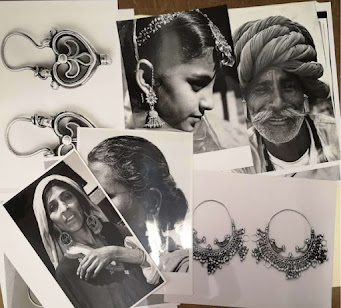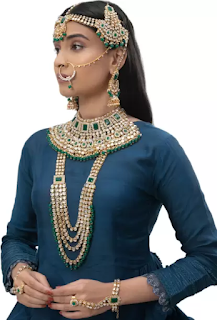The Glorious Journey of Indian Jewellery
www.vam.ac.uk
What is it in jewelry that lures women towards it and has been attracting them for thousands of years? Have you seen how delighted a woman feels when she receives or buys new jewelry? Jewels and ornaments have been part of every woman's life in India, and history gives us enough evidence to prove this right. The most favored one is the yellow metal, which is bought even today by the same enthusiast in various forms be it jewelry or coins. Yes, not just modern women. Our ancestors have been a fan of gold jewelry too. And this love has come a long way since ancient times, and the journey is enthralling enough to make you fall in love with gold.
India's fascination for gold and gold jewelry goes way back 5000 years from the Indus Valley civilization. With a legacy of decades back, traditional Indian jewelry has been a remarkable expression of the country's cultural history and its aesthetics. The jewelry pieces that have survived past periods and different parts of the country backed up with literature, texts, myths, legends, and chronicles confirm an unmatched culture in the world. Culture is so rich in traditions, wealth, and luxury that later the land came to be known as the 'Golden Sparrow' or "Sone ki Chidiya." So, let us dive into history and take a quick look at this exciting journey of Indian gold jewelry through different periods.
2600 and 1900 BCE
With the commencement of the Indus Valley civilization, people developed artistic and intricate engineering skills. That was when India manufactured and exported a vast quantity of beads to the world. The country was also home to the earliest diamonds found. Indian also invented the diamond drill and taught it to the Romans. Trade was made with beads, pure gold coins or silver coins, seashells, or colored gemstones. The craftsmen used semi-precious gems like carnelian, agate, and turquoise and fashioned them into tubular or barrel shapes. These were decorated with carvings, bands, dots, and patterns or were set minutely with gold.
The jewelry pieces that the people of the Indus Valley made and wore speak of their extremely sophisticated lifestyle with a finely developed aesthetic sense. The stunning necklace pieces from the period of Mohenjodaro that still rests in the National Museum in Delhi jewelry gallery are proof of this fact. Along with the great technological proficiency, design continuity is highly commendable.
However, despite the relative simplicity of these early jewelry pieces, Indian jewelry eventually became much more intricate in its style and artistry. In the 2,000 years after the degeneration of Mohenjodaro, the Indian craftsmen had polished their skills immensely. So in the later period, one can see delicate filigree work on gold, embossing work, and detailed micro-granulations on smaller pieces like pendants or unique bracelet designs that made them part of larger items like earrings or necklaces.
4th Century BC to 2nd Century AD
After the decline of Mohenjodaro, jewelry in India took a sudden shift and became more delicate and intricate. During the Sangam era, one of The Five Great Epics of Tamil literature, known as the Silappadikaram talks about a society that dealt with gold, precious stones, and pearls. It also speaks about a Portuguese traveler, the chronicles of Paes, and illustrates stunning jewelry pieces worn by people in the Vijayanagar Empire. These statement pieces embellished with rubies and emeralds were initially crafted only for adorning the temples' idols. However, over time when the dance form Bharatanatyam became popular, this temple jewelry was made accessible to dancers, and later it was widespread among the commoners as heirlooms and trousseau.
1526- 1857
Mughals redefined the way royals wore jewelry. They further embellished traditional Indian jewelry and brought more innovative creation techniques to light. The blend of Central Asian styles with Indian techniques gave rise to the extravagance of elegant ornaments. The world had never seen before this type of exquisite creativity in jewelry. The ancient town of Taxila also found a unique technique decorating metals with a coating known as enameling of jewelry. This technique reached its peak under the Mughals. Sometime later, these ancient Indian jewelry designs were modified to integrate nature-inspired and geometrical designs. Indian artisans eventually perfected the techniques of Mughal Kundan and Jadau jewelry. They later added their unique touches to these ancient designs to make something fresh, unique, and fantastic.
1858 – 1947
During the nineteenth and early twentieth centuries, the country's colonial rulers started influencing Indian jewelry designs and other industries of India. The distinguished European jeweler Cartier started creating precious jewelry for the royal families and Maharajas. And it functioned the other way too. Cartier's popular styles were also inspired by South Indian floral motifs, which were embedded with real rubies, emeralds, and sapphires.
1947 – 2022
After India gained independence, the jewelers could create their motifs and styles. Though it took them some time, they eventually developed astonishing designs that got worldwide appreciation. The modern era saw quite a development in gold and diamond jewelry. With jewelers having more options in metals like white gold, rose gold, platinum, etc., the variety of jewelry motifs started spreading beyond conventional ideas and traditions. Trendy gemstone jewelry also became more vivid with discovering the newest and rare gems and stones. Modern women began experimenting with dressing styles, and jewelry styling also changed drastically.
And 2022 came with several quirky jewelry designs that stunned every jewelry lover. Indian fashion runways saw everything wacky yet trendy, from leather jewelry to feather ornaments. And also, heavy, statement jewelry was replaced with minimal and lightweight pieces that can be worn daily and not just during special occasions. Though the journey of Indian jewelry has been inconsistent and long, it has undoubtedly added to the charisma, multiplying the craze for gold for jewelry lovers.




Comments
Post a Comment